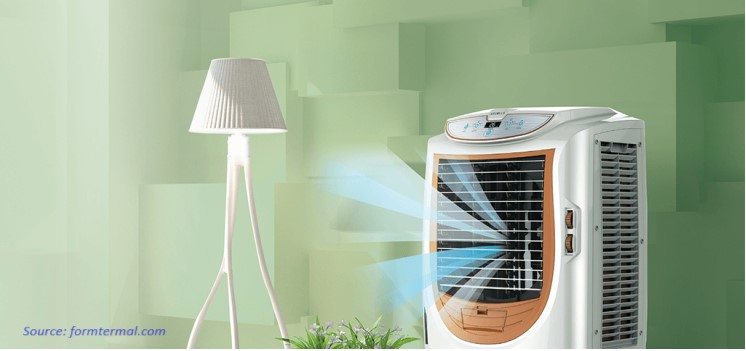
Finland Heat Exchangers Market by Type (Shell & Tube, Plate & Frame, Air Cooled, and Others), by Material (Metals, Alloys, and Brazing-CLAD), and by End User (Chemical, Energy & Power, Heating, Ventilation, Air Conditioning, and Refrigeration (HVACR), Food & Beverage, Pulp & Paper, and Others)– Opportunity Analysis and Industry Forecast, 2024–2030
Industry: Retail and Consumer | Publish Date: 21-Mar-2024 | No of Pages: 118 | No. of Tables: 86 | No. of Figures: 51 | Format: PDF | Report Code : N/A
Market Overview
The Finland Heat Exchangers Market size was valued at USD 61.8 million in 2023 and is predicted to reach USD 98.0 million by 2030, with a CAGR of 6.2% from 2024 to 2030.
Heat exchangers, devices devised to facilitate heat transfer between fluids without direct contact, are widely employed in industrial, commercial, and residential settings, including HVAC systems and refrigeration units, to efficiently heat or cool fluids or air. Operating by permitting heat to traverse a barrier, such as a solid wall or an array of plates or tubes, they can accomplish tasks including heating water in boilers or cooling air in air conditioning systems. Available in various designs customized to specific requirements, ranging from simple radiator coils to complex systems in chemical processing plants and power generation facilities, they serve essential functions across multiple industries and applications.
These functions include regulating air temperature in buildings, facilitating steam production in power plants, controlling temperatures during chemical reactions, and aiding in food processing, among other purposes. Moreover, they serve as critical components in automotive cooling systems and boast widespread applications in aerospace, marine, and wastewater treatment industries, playing a vital role in efficient thermal management and energy transfer.
Stringent Government Regulations Regarding Energy Efficiency Boost Market Expansion
Stringent government regulations regarding energy efficiency serve as a catalyst for boosting market expansion. These regulations compel industries and consumers to adopt energy-efficient solutions, including heat exchangers, to minimize energy consumption and reduce environmental impact.
By enforcing standards and incentives that prioritize energy efficiency, governments create a favorable environment for the growth of the heat exchangers market. Additionally, such regulations drive innovation and encourage investments in advanced technologies that enhance the efficiency of heat exchange processes. As a result, manufacturers and suppliers of heat exchangers experience increased demand for their products, leading to market expansion.
Growing Demand for Renewable Energy Drives Finland’s Market Expansion
The growing demand for renewable energy is a driving force behind the expansion of Finland's market. As the country endeavors to transition towards cleaner and more sustainable energy sources, there is a heightened need for heat exchangers that can efficiently harness and distribute renewable heat. Heat exchangers play a vital role in various renewable energy systems, including biomass boilers, heat pumps, and solar thermal systems, by facilitating the transfer of heat between different mediums.
With Finland's commitment to increasing renewable energy generation and reducing carbon emissions, the demand for heat exchangers tailored to renewable energy applications is expected to rise significantly, driving market expansion in the country.
High Installation and Maintenance Costs Restrain Market Growth
High installation and maintenance costs serve as a hindrance to market growth. Although heat exchangers provide effective heat transfer solutions, the initial investment for installation and ongoing maintenance can be substantial. This financial burden often dissuades businesses, especially those with limited financial resources, from embracing heat exchangers technologies.
Moreover, despite the potential long-term savings offered by energy-efficient heat exchangers, the need for regular maintenance and operational expenses such as cleaning and repairs adds to the overall ownership costs. Consequently, the perceived financial obstacle related to high installation and maintenance expenses restricts the widespread adoption of heat exchangers, thus restraining market growth in specific sectors.
Advancements in Cutting-Edge Materials and the Rising Trend of Industry 4.0 Create a Market Opportunity
The incorporation of cutting-edge materials such as graphene and advanced ceramics marks a significant leap forward in heat exchangers technology. These materials exhibit outstanding properties such as high thermal conductivity and corrosion resistance, offering immense potential to enhance efficiency, durability, and overall performance across diverse industries including HVACR, automotive, aerospace, and renewable energy.
Leveraging these unique attributes, heat exchangers can facilitate more effective heat transfer and better withstand challenging operating conditions, thereby improving reliability and extending lifespan. Moreover, the adoption of advanced materials can result in decreased energy consumption and prolonged service life, providing significant advantages in terms of operational efficiency and sustainability across various sectors.
Additionally, the emergence of Industry 4.0, characterized by the integration of automation, data exchange, and digital technologies in manufacturing processes, presents further opportunities for advancing heat exchangers technology.
By utilizing enhanced monitoring, control, and optimization capabilities enabled by Industry 4.0 technologies, heat exchangers can achieve heightened efficiency and productivity. Consequently, the convergence of advanced materials and Industry 4.0 innovations is poised to foster innovation and growth in the heat exchangers market, delivering enhanced performance and sustainability across a wide range of industrial applications.
Competitive Landscape
Several market players operating in Finland’s heat exchangers market include Alfa Laval AB, Johnson Controls International plc, Carrier Global Corporation, Lennox International Inc., Trane Technologies plc, API Heat Transfer Inc., Kelvion Holding GmbH, Xylem Inc., Danfoss Group, and General Electric Company among others. These companies are adopting various strategies such as product launches to remain dominant in the heat exchangers market.
Key Market Segments
By Type
-
Shell & Tube
-
Fixed Tube Heat Exchangers
-
U-Tube Heat Exchangers
-
Floating Head Heat Exchangers
-
Other Shell & Tube Heat Exchangers
-
-
Plate & Frame Heat Exchangers
-
Gasketed Plate & Frame Heat Exchangers
-
Welded Plate & Frame Heat Exchangers
-
Brazed Plate & Frame Heat Exchangers
-
Other Plate & Frame Heat Exchangers
-
-
Air Cooled
-
Forced Draft Heat Exchangers
-
Induced Draft Heat Exchangers
-
-
Others
By Materials
-
Metals
-
Alloys
-
Brazing-CLAD
By End User
-
Chemical
-
Energy & Power
-
HVACR
-
Food & Beverage
-
Pulp & Paper
-
Others
REPORT SCOPE AND SEGMENTATION:
|
Parameters |
Details |
|
Market Size in 2023 |
USD 61.8 Million |
|
Revenue Forecast in 2030 |
USD 98.0 Million |
|
Growth Rate |
CAGR of 6.2% from 2024 to 2030 |
|
Analysis Period |
2023–2030 |
|
Base Year Considered |
2023 |
|
Forecast Period |
2024–2030 |
|
Market Size Estimation |
Million (USD) |
|
Growth Factors |
|
|
Companies Profiled |
10 |
|
Market Share |
Available for 10 companies |
|
Customization Scope |
Free customization (equivalent up to 80 working hours of analysts) after purchase. Addition or alteration to country, regional, and segment scope. |
|
Pricing and Purchase Options |
Avail customized purchase options to meet your exact research needs. |
KEY PLAYERS
-
Alfa Laval AB
-
Johnson Controls International plc
-
Carrier Global Corporation
-
Lennox International Inc.
-
Trane Technologies plc
-
API Heat Transfer Inc.
-
Kelvion Holding GmbH
-
Xylem Inc.
-
Danfoss Group
-
General Electric Company




 Speak to Our Analyst
Speak to Our Analyst


































